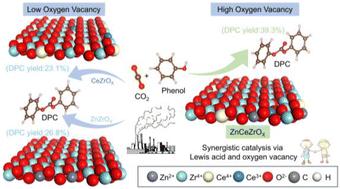Diphenyl carbonate synthesis from CO2 over a ZnCeZrOX ternary solid solution: synergistic catalysis using oxygen vacancies and Lewis acid sites†
IF 4.2
3区 化学
Q2 CHEMISTRY, PHYSICAL
引用次数: 0
Abstract
The direct synthesis of diphenyl carbonate (DPC) from CO2 and phenol has attracted much attention as it can realize CO2 utilization and can avoid phosgene usage in the traditional production process. Nevertheless, the achievement of high DPC yields is hindered by the difficult activation of CO2. Herein, a dual metal incorporated ZnCeZrOX catalyst was synthesized, and the synergistic catalysis mechanism between oxygen vacancies and Lewis acid sites was systematically demonstrated. Raman and EPR analyses revealed that the simultaneous introduction of Zn and Ce effectively promoted the formation of abundant oxygen vacancies, thereby enhancing the adsorption and activation of CO2. NH3-TPD and Py-IR characterizations demonstrated that dual doping of Zn and Ce modulated Lewis acidity, benefiting the adsorption of phenol and intermediates. Compared with ZnZrOX and CeZrOX, the ZnCeZrOX catalyst demonstrated superior catalytic performance, achieving a phenol conversion of 47.6% and a DPC selectivity of 82.5%. DFT and in situ FTIR analyses indicated that oxygen vacancies activated CO2 to form b-CO32− species, while Lewis acid sites adsorbed phenol to facilitate the dissociation of the Ophenol–H bond, synergistically generating DPC. This study demonstrates synergistic catalysis using oxygen vacancies and Lewis acid sites, opening a novel avenue for DPC synthesis.

ZnCeZrOX三元固溶体上CO2合成碳酸二苯酯:氧空位和路易斯酸位的协同催化
以CO2和苯酚为原料直接合成碳酸二苯酯(DPC),既能实现CO2的利用,又能避免传统生产工艺中光气的使用,受到了广泛的关注。然而,高DPC产率的实现受到CO2难以活化的阻碍。本文合成了一种双金属掺杂的ZnCeZrOX催化剂,并系统地论证了氧空位与Lewis酸位点之间的协同催化机理。Raman和EPR分析表明,同时引入Zn和Ce有效地促进了丰富氧空位的形成,从而增强了CO2的吸附和活化。NH3-TPD和Py-IR表征表明,Zn和Ce的双掺杂调节了Lewis酸度,有利于苯酚和中间体的吸附。与ZnZrOX和CeZrOX相比,ZnCeZrOX催化剂表现出更优异的催化性能,苯酚转化率为47.6%,DPC选择性为82.5%。DFT和原位FTIR分析表明,氧空位激活CO2形成b-CO32−,而Lewis酸位点吸附苯酚促进苯酚- h键的解离,协同生成DPC。本研究证实了氧空位和Lewis酸位点的协同催化作用,为合成DPC开辟了一条新的途径。
本文章由计算机程序翻译,如有差异,请以英文原文为准。
求助全文
约1分钟内获得全文
求助全文
来源期刊

Catalysis Science & Technology
CHEMISTRY, PHYSICAL-
CiteScore
8.70
自引率
6.00%
发文量
587
审稿时长
1.5 months
期刊介绍:
A multidisciplinary journal focusing on cutting edge research across all fundamental science and technological aspects of catalysis.
Editor-in-chief: Bert Weckhuysen
Impact factor: 5.0
Time to first decision (peer reviewed only): 31 days
 求助内容:
求助内容: 应助结果提醒方式:
应助结果提醒方式:


